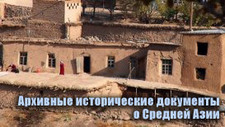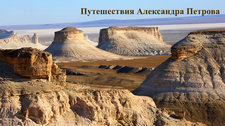You are here
Pashennoye lake in Karkaraly Park.
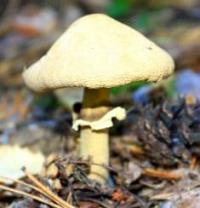
A trip from Karaganda to Karkaralinsk.
"Familiarity with almost all the geographical and geological literature on Central Asia allows me to assert that the contribution of Russian scientists to the study of this vast region exceeds that of all other researchers combined."
Academician V. A. Obruchev.
A trip to Karkaraly park.
Lake Pashennoye – natural gem of Karkaraly Massif.
Lake Pashennoye (Samal) is located at an altitude of 881.9 meters above sea level, 7.5 kilometers southwest of city of Karkaraly, 8.6 kilometers southwest of Lake Bolshoe, 3.5 kilometers south and slightly east of Lake Shaitankol, in Karkaraly Mountains, within Karkaraly Nature Park, in district of same name, in eastern Karaganda Region.
Lake stretches 1.3 kilometers from southeast to northwest, reaching its greatest width in the central part at 811 meters. Its surface area is 689,198.86 square meters, and its shoreline is 3,543.99 meters long. The average depth is 4-5 meters, and the maximum depth does not exceed 7 meters.
On the eastern shore of the lake, 130 meters away, is the Shakhtyor health resort and rest home for Karaganda miners. From the resort, you can take walks and excursions around the area in search of mushrooms and berries, climb Pioneer Peak, and explore the unique sites of the natural park, including Lake Shaitankol or Lake Bassein.
In winter, you can visit the ski slope with a cable car. The lake is located in an intermountain basin in the Karkaraly Mountains. The lake is endorheic; the small Ayakoga Stream flows into it.
Legend of origin of Lake Pashennoye in Karkaraly Park.
Since ancient times, the residents of Karkaraly have told a legend about a young man named Pashennoye, the son of a hunter, who fell in love with the daughter of the heavenly spirits who descended to earth at the foot of the mountains. The girl promised to marry him if he brought water from all the mountain springs that fed the valley.
Pashennoye walked for three days and three nights, filling vessels with spring water. But when he returned, the spirits were angry - a human being shouldn't possess the water of all the mountains. The vessels broke, and the waters mixed to form a lake.
Since then, people have called it Pashennoye, in memory of the brave youth and the purity of his heart.
There is another legend about Lake Pashennoye: the body of water had an ancient Kazakh name -Kishkenekol (small lake), but this was soon forgotten. Orthodox Christians erected a wooden cross on the shore. No one now remembers who was buried there.
Another name was Grishkekol - Grishkino Lake. The Cossacks, having settled here, chose this place for their crops. Due to crop failures, many later abandoned farming. Only one man, Grigory, persisted. His agrarian soul grumbled against the injustice of nature.
The plow marks remained, becoming a noticeable landmark for the locals. The abandoned fields gave rise to a new name - Pashennoye.
Physical and geographical characteristics of Lake Pashennoye in Karkaraly Park.
Lake Pashennoye is located in one of the tectonic basins of the Karkaraly lowlands, in the eastern Karaganda region. The lake is surrounded by mountains rising to approximately 1,000 meters above sea level. These slopes are composed primarily of ancient granite, eroded by time and wind.
On the southern side, the mountainous rim breaks, and it is here that the Kuruzek Stream flows out of the lake, connecting Pashennoye with a system of small streams in the surrounding area. The lake's shape is roughly oval, extending from northwest to southeast.
In recent decades, the lake has been rapidly overgrowing, with floating plant mats, or floats, up to one and a half meters thick, increasingly forming on its surface. Young floats appear as loose carpets of dead vegetation, covered with horsetail and sedge, while older areas develop into stable islands overgrown with shrubs, birch, and aspen.
By the end of the 20th century, the floats occupied more than half the lake's surface, significantly altering its ecological appearance. The region's climate is typically continental. Average July temperatures in the Karkaraly area range from 18 to 19°C, and January temperatures range from –14 to –15°C, with the annual average temperature hovering around 2°C.
Annual precipitation is approximately 300 millimeters (according to the USSR Climate Handbook, 1966). These conditions contribute to strong seasonal variability in the lake's water regime: the water level rises in the spring, evaporation increases in the summer, and in winter the lake is covered with a thick layer of ice.
Currently, the lake's ecosystem is experiencing significant anthropogenic impact. Boarding houses, holiday homes, and former holiday camps are located near the shores, increasing the pressure on the watershed. Additional changes are associated with water intake and the discharge of wastewater.
All of this requires a careful approach to preserving the natural balance - to ensure that Lake Pashenny remains a picturesque symbol of the Karkaraly Mountains and does not become an example of the fragility of ecosystems under human influence.
In the spring, the lake fills with meltwater, in the summer the level drops due to evaporation, and in winter it is covered with ice over 70 cm thick.
History of study of Lake Pashenny in Karkaraly National Park.
The first scientific references to Lake Pashennoye date back to the late XIXth century, when explorers from the Karkaraly Mountain District - geologists, botanists, and topographers - came here. In the early 20th century, the lake was repeatedly visited by expeditions led by Karkaraly foresters, who compiled the first descriptions of the area's vegetation and hydrology.
During the Soviet era, Pashennoye became a well-known site for hydrobiological observations. From the 1960s to the 1980s, scientists recorded the process of overgrowing and changes in the water's chemical composition. By 1990, more than half of the lake's surface was covered by floating bogs, as noted in reports from the Karaganda Pedagogical University and the Institute of Botany of the Academy of Sciences of the Kazakh SSR.
Flora and fauna of Lake Pashennoye in Karkaraly Park.
The shores of Pashennoye are rich in vegetation. Sedge, cattail, horsetail, and reeds grow here, while the coastal forests are home to birch, aspen, pine, willow, and meadowsweet. Along the southern shores, thickets of blueberries and lingonberries are found.
The lake's fauna includes waterfowl, including mallards, teals, coots, grey herons, and glossy ibis. The surrounding forests are home to black grouse, wood grouse, squirrels, chipmunks, foxes, and wild boars. Fish include crucian carp, roach, and pike, although their numbers are small due to the periodic drying up of the tributaries.
The lake is also an important breeding ground for amphibians, with numerous green frogs and newts. The reservoir and adjacent marshes provide favorable habitat for a variety of insects, including dragonflies, diving beetles, and butterflies, which are especially abundant in the summer.
Current state and protection of Lake Pashennoye in Karkaraly National Park.
In recent decades, the lake's ecosystem has experienced significant anthropogenic pressure. Former pioneer camps, boarding houses, and holiday homes are located near its shores. As a result of recreational impacts, water intake, and domestic wastewater, the lake has experienced accelerated overgrowth and siltation.
Nevertheless, the lake is located within the Karkaraly State National Nature Park, which ensures its protected status. Hydrological monitoring and flora are conducted, construction in the coastal zone is limited, and nature trails allow visitors to enjoy nature without harming the ecosystem.
Based on the total mineralization of its water, Lake Pashennoye (Samal) is classified as ultra-fresh. The lake water is soft, of the bicarbonate class of calcium group. Five species of fish inhabit the lake: pike, crucian carp (golden and silver carp), roach, and perch.
Natural attractions surrounding Lake Pashennoye in Karkaraly Park.
The area around Lake Pashennoye offers a striking diversity of landscapes. A few kilometers to the east lies Lake Bolshoye, one of the park's most famous bodies of water, and to the northwest are the Shankoz Mountains, with panoramic views and bizarrely shaped rock outcrops.
Nearby is Mount Buguly, adorned with rare relict pine forests and blooming steppe meadows. Hiking trails lead to observation platforms offering views of the valleys and granite domes of Karkaraly. Lake Pashennoye, surrounded by quiet forests and reflecting the sky, remains a place where you can feel the breath of ancient nature and the echoes of ancient legends.
Geographic coordinates of Lake Pashennoye are: N49°21'54 E75°23'54
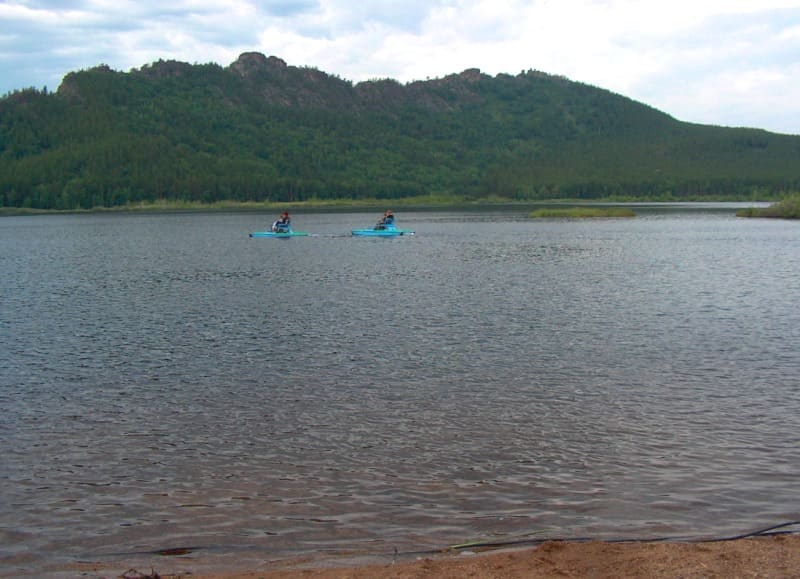
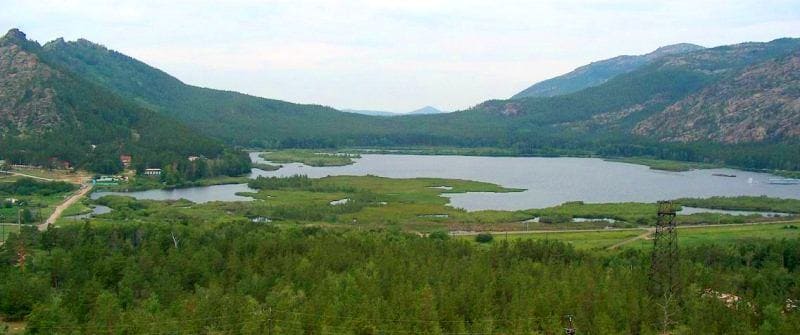
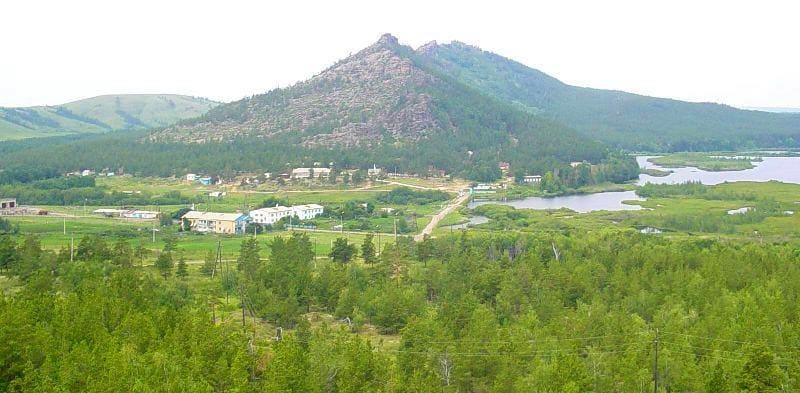
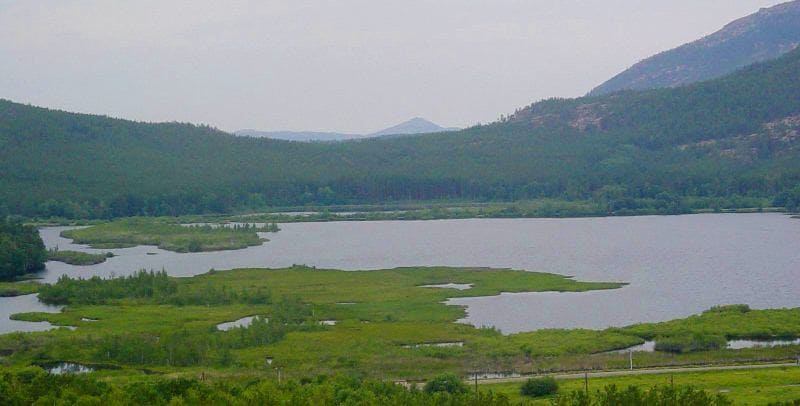
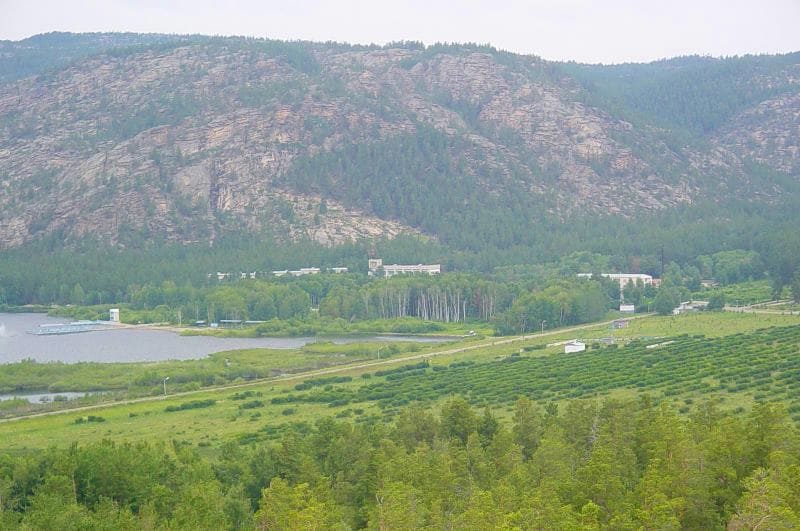
Authority and photos by:
Alexander Petrov.





